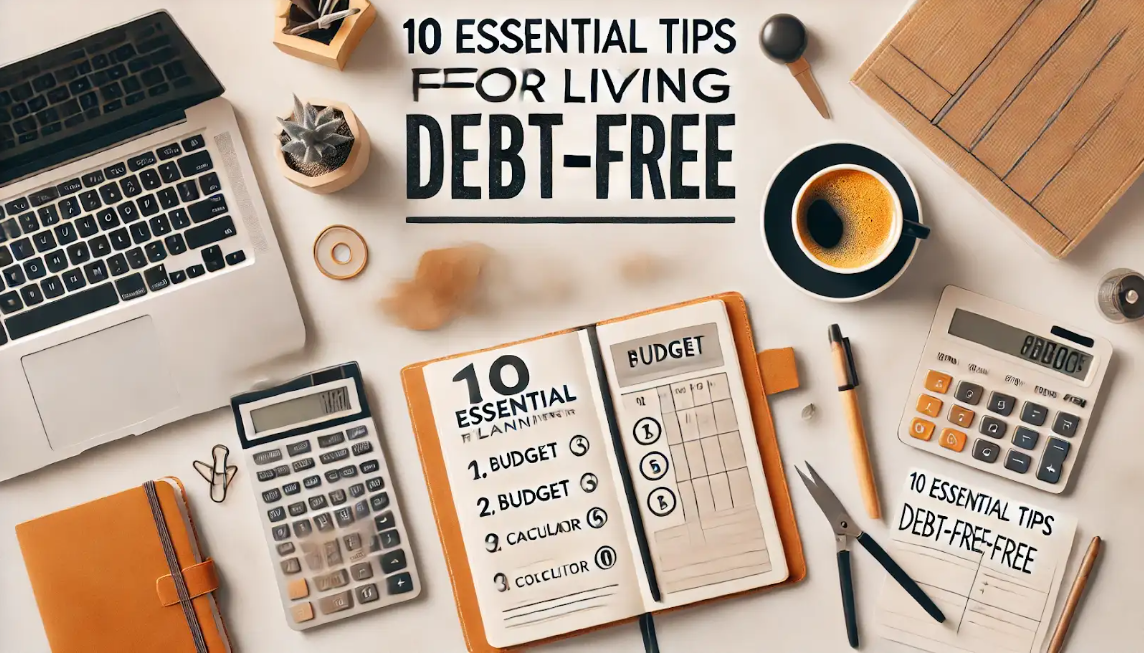Ever wonder how life could look if you didn’t have debt weighing you down? Living debt-free is not just a goal but a lifestyle that brings peace of mind and financial security. Imagine being able to tackle emergencies without stress, knowing your money is your own. Building a debt-free life isn’t reserved for a select few; it’s a journey anyone can take with the right strategies and habits.
In this guide, we’ll cover ten essential steps to living debt-free. These steps aren’t quick fixes but proven approaches that lead to a life free from financial burdens. As you read, consider how these habits could make a lasting difference in your life and help you find financial freedom.
Tips for Living a Debt-Free Life
Now let’s explore some valuable tips for living a debt-free life:
1. Setting Up a Budget
A budget is the backbone of any debt-free plan. Think of it as a roadmap guiding every dollar toward your financial goals. Without a budget, it’s easy to lose track of spending, even if you have the best intentions. Setting up a budget doesn’t have to be complex, and it’s not about restriction. Instead, a good budget gives you freedom by helping you see where your money goes and how you can manage it better.
Start by listing all your income sources. This could include your salary, freelance work, or side hustles. Then, jot down your fixed expenses, like rent, utilities, and car payments, followed by variable expenses like groceries, dining out, and entertainment. Once you have these down, compare your income to your total expenses. If you’re spending more than you’re making, it’s time to cut back or find ways to boost your income.
Use budgeting tools if you prefer a tech-savvy approach, or go old-school with a notebook. Apps like Mint, You Need a Budget (YNAB), or a simple spreadsheet can help you track your spending habits. The goal is to get a clear picture of where you are financially and create a plan that ensures you live within your means. Once your budget is in place, review it regularly. Financial needs change, and your budget should evolve with you.
A well-structured budget is one of the most powerful tools you have on your path to financial independence. It’s not just about tracking expenses; it’s about giving every dollar a purpose.
2. Avoiding Credit Card Debt
Credit card debt can sneak up on anyone, and it’s one of the fastest ways to fall into financial trouble. Credit cards are convenient, but the high interest rates make it all too easy to get trapped in a cycle of minimum payments and growing debt. The best way to avoid this is to rethink how you use credit.
First, if you can, stick to using cash or debit cards for everyday purchases. This way, you’re only spending what you have on hand. If you do use a credit card, make it a rule to pay off the balance in full each month to avoid interest charges. One powerful approach is to treat your credit card like a debit card. Only spend on it what you can pay back right away, so you’re never caught off guard by a big bill at the end of the month.
To further manage credit card debt, try setting a low credit limit. A lower limit can help prevent overspending and keep your debt in check. Also, consider consolidating your debt if you’re already struggling with multiple cards. Working with a company like Freedom Debt Relief can be helpful if you need structured support and a plan to pay off your debt faster. Their guidance could help you avoid interest piling up and ultimately gain control over your finances.
Avoiding credit card debt is about keeping control of your spending and using credit wisely. Make purchases with purpose, and whenever possible, avoid using your card for impulse buys. Small changes in spending habits can lead to big financial wins over time.
3. Building an Emergency Fund
An emergency fund is like a financial safety net, there to catch you when life throws an unexpected expense your way. Without this fund, even minor emergencies—a sudden car repair or medical bill—could push you into debt. Building an emergency fund is essential for living a debt-free life, and it’s easier to start than you might think.
Begin by setting a goal to save at least three to six months’ worth of living expenses. This fund should cover essentials like rent, utilities, groceries, and basic transportation. Don’t worry if this goal sounds large; the key is to start small. Even setting aside $25 or $50 from each paycheck can make a big difference over time.
To keep your emergency fund separate from your daily spending, consider opening a dedicated savings account for it. Many people find that out-of-sight, out-of-mind thinking makes it easier to save without feeling tempted to dip into it. Also, aim to automate your savings. Set up an automatic transfer to your emergency fund account each time you get paid. Automation makes saving effortless and ensures you’re consistently adding to your fund.
Building an emergency fund is a gradual process, but it’s one of the best ways to protect yourself from unexpected expenses that could lead to debt. Once you’ve established this fund, you’ll feel more secure, knowing you have a cushion to fall back on, keeping you in control of your finances no matter what comes your way.
4. Prioritizing Debt Repayment
Debt can feel overwhelming, but paying it down doesn’t have to be complicated. Prioritizing debt repayment is about creating a focused plan that helps you tackle your balances one at a time. Two popular methods to approach this are the debt snowball and debt avalanche methods. Each has its advantages, so choose the one that aligns best with your goals and motivation.
The debt snowball method involves paying off your smallest debts first. Start by listing all your debts and arranging them from smallest to largest. Make minimum payments on all but the smallest debt, where you’ll put any extra funds. As you clear each small debt, move on to the next one, applying the extra money you saved from the previous debt. This method builds momentum and motivation as you see debts disappear one by one.
Alternatively, the debt avalanche method targets high-interest debts first, which saves you the most money in the long run. List your debts by interest rate, from highest to lowest. Focus your extra payments on the debt with the highest interest while making minimum payments on others. This approach may take a little longer to see results, but it’s incredibly effective for cutting down on interest payments.
Whichever strategy you choose, consistency is key. Setting up automated payments can ensure you never miss a due date and prevent extra fees or penalties. Also, avoid taking on new debt while you’re in the repayment phase. Commit to using cash or debit for purchases to stay focused on eliminating your balances. Remember, every payment you make is a step closer to financial freedom.
5. Practicing Smart Spending
Smart spending is about making conscious choices that align with your financial goals. It doesn’t mean cutting out everything fun, but rather recognizing the difference between needs and wants. When you practice smart spending, every purchase feels purposeful, and you stay in control of your finances without feeling deprived.
Start by evaluating your essential expenses. These include housing, groceries, utilities, and transportation. Take note of where your money goes each month and look for areas to cut back. Can you meal prep to save on dining out? Or maybe carpooling could reduce transportation costs. Little adjustments add up over time and can make a big impact on your budget.
For non-essential purchases, adopt a “24-hour rule” to prevent impulse buys. If you’re considering something that isn’t necessary, give yourself a day to think it over. This simple delay can help you determine if it’s something you truly want or just a fleeting impulse. Also, set aside a portion of your budget specifically for entertainment or “fun money.” Knowing you have a dedicated amount to spend guilt-free can keep you from overspending and help you stick to your budget.
Smart spending doesn’t mean being restrictive; it’s about prioritizing what matters most. The goal is to make your money work for you, letting you enjoy life without worrying about debt. By creating mindful spending habits, you’ll find it easier to stay debt-free and enjoy a balanced financial life.
6. Setting Financial Goals
Every debt-free journey starts with clear financial goals. Goals give you direction and purpose, helping you stay motivated even when the road gets tough. Without specific goals, it’s easy to lose track and fall back into old spending habits. But when you set clear, realistic objectives, you know exactly what you’re working toward and can measure your progress along the way.
Begin by defining what financial freedom looks like to you. Do you want to pay off all your credit cards, save for a home, or build a strong retirement fund? Whatever it is, make it specific and measurable. Instead of saying, “I want to save money,” set a target like, “I want to save $5,000 in the next year.” Breaking down your goal into monthly or weekly targets makes it easier to track and keeps you motivated.
Consider both short-term and long-term goals. Short-term goals, like paying off a small loan or saving for a vacation, give you quick wins, boosting your motivation. Long-term goals, such as saving for retirement or paying off a mortgage, require patience and consistent effort but bring tremendous rewards. Having a mix of both types helps you build momentum and see progress regularly.
Remember to review your goals regularly. Life changes, and so might your priorities. Reassess every few months to ensure your goals still match where you want to go. Financial goals keep you focused and give you a sense of accomplishment with every step you take. They are the backbone of a debt-free, financially secure life.
7. Living Below Your Means
Living below your means is a fundamental principle of financial health. It’s the practice of spending less than you earn, freeing up money for savings, debt repayment, and future investments. When you live below your means, you’re not just saving money—you’re setting yourself up for long-term financial freedom.
The first step to living below your means is understanding where your money goes. Track your expenses for a month or two to see where you might be overspending. From there, identify areas where you can cut back. Maybe it’s reducing how often you eat out, switching to a more affordable cell phone plan, or canceling unused subscriptions. These small changes can add up to big savings over time.
It’s also helpful to develop a mindset shift. Instead of feeling restricted, view living below your means as a form of empowerment. It’s a way to prioritize what truly matters, freeing you from unnecessary stress and allowing you to enjoy the things that bring real value to your life. For example, rather than upgrading to the latest phone model, consider keeping your current one for a few more years and using that extra money to build your savings or pay off debt.
Living below your means doesn’t mean sacrificing everything. It’s about making choices that align with your financial goals and putting yourself in control of your money. The freedom that comes from managing your expenses and avoiding debt far outweighs the temporary thrill of unnecessary purchases. This approach not only helps you stay debt-free but also brings peace of mind knowing you’re building a secure financial future.
8. Cultivating Financial Discipline
Financial discipline is the skill that holds your budget, savings, and spending in balance. Without it, even the best financial plans can fall apart. Discipline keeps you from making impulse purchases and ensures you stay focused on long-term goals rather than short-term desires. But like any skill, financial discipline takes practice and dedication.
Start by setting limits on your spending. For each pay period, decide on a specific amount for essentials, savings, and personal spending. If you tend to spend on impulse, try a “cooling-off period” for non-essential purchases. Wait at least 24 hours before buying something unplanned. Often, you’ll find that the initial urge fades, saving you money and reducing unnecessary clutter.
To build financial discipline, focus on creating routines that make saving automatic. Set up a direct transfer to your savings account each payday so that part of your income goes toward your goals before you even see it. This approach helps you treat savings as a priority, not an afterthought, and gradually strengthens your habit of living within your means.
Discipline doesn’t mean never having fun—it’s about making intentional choices that align with your values. When you learn to delay gratification and keep your spending in check, you gain greater control over your finances. This allows you to confidently work toward your goals without sacrificing your financial stability.
9. Building Passive Income Streams
Imagine earning money while you sleep or go about your daily routine. That’s the magic of passive income. Building passive income streams can provide you with extra cash flow, boost your savings, and even pave the way to early retirement. It’s a key strategy for anyone seeking long-term financial independence.
There are many ways to start building passive income. Investing in stocks, bonds, or index funds is one popular method. By putting your money into reliable, long-term investments, you can earn returns that grow over time. Real estate is another common path, where rental properties can generate monthly income. If real estate sounds daunting, consider alternatives like Real Estate Investment Trusts (REITs), which let you invest in property without owning physical assets.
For those interested in creative income streams, think about selling digital products like e-books, online courses, or design templates. These require some initial time and effort but can earn income repeatedly without additional work. You could also consider affiliate marketing if you have a blog, social media presence, or YouTube channel. By promoting products you believe in, you can earn a percentage of sales while providing value to your audience.
Creating passive income isn’t an overnight process, but it’s worth the time and energy. Start with one stream, build it, and then add others gradually. The goal is to create a diverse portfolio of income sources that provide a safety net and financial freedom over time. Passive income allows you to worry less about finances and focus more on living the life you want.
10. Embracing Generosity
Generosity might seem like an unexpected tip on the road to financial freedom, but it plays a vital role in creating a fulfilling, debt-free life. Giving, whether it’s your time, resources, or money, cultivates a sense of gratitude and shifts your focus from “what do I lack” to “what do I have to give.” This mindset can be transformative, creating positive habits that support long-term financial health.
Giving back doesn’t have to mean big financial donations. You can start by volunteering, helping a friend in need, or donating small amounts to causes you believe in. The act of giving, no matter the amount, fosters a positive relationship with money. It reminds you that financial freedom isn’t just about what you gain, but also about what you can share.
Generosity also helps reduce financial stress. When you view your money as a tool for positive change, it reduces the fear of scarcity and increases your motivation to manage it wisely. Many people find that the act of giving helps them value their own financial goals even more, encouraging responsible spending and saving habits. Embracing generosity allows you to feel more connected to your community, adding purpose to your financial journey.
Conclusion
Living a debt-free life is about more than just avoiding debt—it’s about building a life of security, freedom, and peace of mind. With each step, from budgeting and disciplined spending to setting financial goals and embracing generosity, you move closer to a stable and fulfilling financial future.
Taking control of your finances may seem daunting, but remember that each positive change adds up. Every time you prioritize saving, avoid credit card debt, or build passive income, you’re creating a solid foundation for financial success. Start with small steps and stay consistent, and soon, living debt-free will become more than just a goal; it will be your reality.
A debt-free life offers more than financial security. It brings you the freedom to pursue dreams, help others, and enjoy peace of mind. These ten tips provide a roadmap to lasting financial independence, empowering you to live the life you’ve always wanted—without the weight of debt holding you back.
Keep an eye for more latest news & updates on Buzz Slash!




